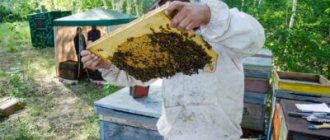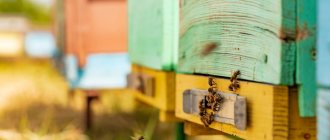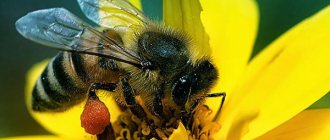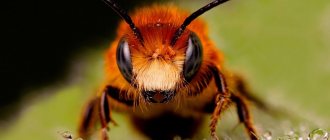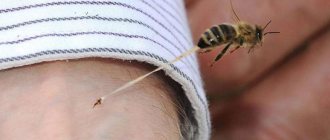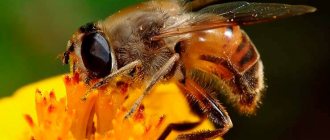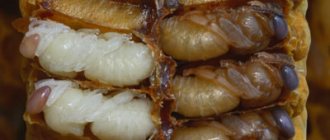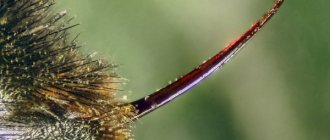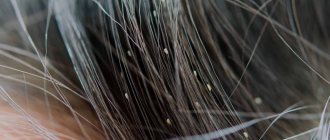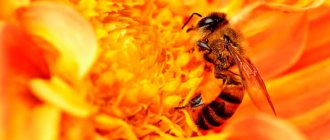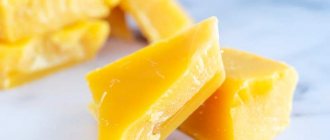A beehive is a separate, interesting world, with a special hierarchy.
Here, each bee occupies an important place and brings benefits to its family. To obtain honey in good quantities, every novice beekeeper must first of all know how bees reproduce and develop.
There are three types of bees in each hive:
- The queen of the hive is the queen bee. Its main function is the production of new individuals.
- Working insects - these individuals produce honey and care for the new brood, queen and drones.
- Drones are male individuals whose main task is to fertilize the uterus.
Development of a bee embryo in an egg
The structure of a bee
The egg laid by the queen is glued to the bottom of the cell and is initially located parallel to the walls of the cell.
The development of the embryo in the egg lasts about three days. As the embryo develops, the egg leans more and more to one side, and on the third day it lies at the bottom of the cell. Judging by the position of the egg in the cell, it is possible to determine the time of its laying by the queen (Fig. 12).
By the end of the third day, the shell of the egg bursts and a larva is born - a small milky-white worm. Shortly before the larva emerges, nurse bees place food (milk) into the cell of the honeycomb in an amount that is two to four times the weight of the larva. Until the food is placed in the cell and wets the shell of the egg, the larva will not hatch from the egg. If food is not supplied at all, the egg dries out and turns black.
What is a bee colony?
Thanks to the dependence of each family member on each other, a huge amount of pollen and honey is collected, and optimal temperature and humidity are maintained in the hive compartments. Bees can reproduce and defend themselves from any enemies.
Each bee colony has its own specific characteristics:
- smell;
- polishing nests;
- resistance to winter conditions;
- ability to grow and collect honey;
- performance;
- tendency to get sick;
- level of aggressiveness.
The uterus plays a huge role in the family, after replacing which the conditions may change. This is due to the fact that generations change, and so does heredity.
The family consists of the following members:
- uterus - one;
- working individuals - females with an underdeveloped reproductive system;
- drones are males.
In general, in a family there can be 80,000 bees in the summer, and 20,000 in the winter. Insects can develop intensively mainly under favorable conditions. This is the right temperature, sufficient amount of feed. Bee growth slows down in autumn and stops in winter.
Bee larval development
The larva emerging from the egg looks like a legless worm and lies motionless at the bottom of the cell with a curl in the shape of the letter “C”. As it grows, it more and more takes the shape of a ring, and the grown larva stretches along the cell.
Development of a worker bee
Eggs: / – an egg just laid by the queen; 2 – yayio on the second day; 3 – three-day egg.
Larvae: 4 – one-day old; 5 – two-day; 6 – three days; 7 – four days; 8 – six-day (cell printing begins). Pupae: 9 – transformation of the larva into a pupa; 10 – pupa at rest.
The body of the larva is covered with a thin chitinous skin. The larva does not yet resemble a bee in any way. It lacks wings, legs and other appendages of adult bees. Its internal organs are also structured differently: there is no honey crop yet, and the midgut occupies most of the larva’s body and is a tube that does not communicate with the rectum. Therefore, the larva does not defecate, and all the feces accumulate in its midgut. Only at the end of the larval stage, just before pupation, the accumulated feces breaks through the thin partition separating the midgut from the rectum and is ejected to the bottom of the cell.
During growth, the larva molts four times, that is, it sheds its shell, which becomes tight; each time, instead of the shed one, a new, more spacious skin grows.
Bee development
What does a bee larva eat?
During the first time of its life, the larva receives very nutritious food - milk. By the end of the third day, the larvae of worker “bees” begin to receive coarser food - a gruel consisting of a mixture of honey and bee bread. The larvae are very voracious. Nurse bees continually add food to them. But they grow quickly: by the end of the sixth day, the worker bee larva already fills the entire cell, increasing in weight by more than 1300 times.
The abundance of food consumed leads to the accumulation in the larva's body of a large amount of nutrients in the form of a fat body, constituting up to 65% of the larva's weight. Its reserves of nutrients are consumed during further development - in the pupal stage, which does not receive or eat food.
When does a bee larva emerge from the cell?
When the larva grows, it stops consuming food and stretches its head towards the exit of the cell. By the end of the sixth day of the larval stage, the bees seal the cell with the larva with a porous lid consisting of wax mixed with pollen. This cap does not interfere with air exchange. The larvae before sealing are called open brood, after sealing - closed, or sealed brood, and the eggs laid by the queen until the larvae hatch from them are usually called seeding
In a sealed cell, the larva molts for the fifth time, and then spins a dense brown cocoon around itself and within 24 hours turns into a motionless pupa, basically already similar to an adult bee.
The pupa is initially white. However, soon it gradually darkens, and first of all the eyes acquire a purple tint, and then the head, chest, and abdomen darken.
Usually on the 11th or 12th day after the cell is sealed, the last (sixth) molt occurs. And by the end of the 12th day, the bee gnaws through the lid of the cell and goes outside. The shells (“shirts”) of larvae and pupae and the feces of the larvae remain in the cells, changing the color of the comb.
The entire development of a worker bee, from the egg stage to its exit from the cell, lasts 21 days.
Medicinal properties of bee brood
Due to the large amount of food consumed, the accumulation of nutrients in the larvae’s body occurs rapidly. All types of bee brood have a beneficial effect on the human body and help cure many diseases.
Benefits of bee brood for humans:
- strengthening the immune system;
- restoration of strength;
- help with rickets and dystrophy thanks to the fatty acids included in the larva;
- stabilization of blood pressure;
- strengthening blood vessels;
- lowering cholesterol levels;
- cancer prevention.
Additional Information! The antioxidants in bee jelly have an anti-aging effect and are often used in cosmetics.
Features of uterine development
Queens and worker bees develop from the same fertilized eggs; in this case, bees are hatched in bee cells, and queens are hatched in queen cells. However, the appearance of a queen or worker bee depends not only on the size and shape of the cells. The quality of food plays a decisive role in the formation of these two forms of females: the larvae of future queens feed only on milk all the time, and the larvae of worker bees, starting from the age of three days, receive coarser food - gruel.
Bee development table
The egg stage in queen bees, as well as in worker bees, lasts three days, but the cell with the queen larva is sealed somewhat earlier - after five days (in worker bees - by the end of the sixth day). In a sealed queen cell, the uterus develops within eight days, and the entire development of the uterus lasts 16 days.
In beekeeping practice, however, such a long period of time is not required to hatch queens. When artificially hatching queens, the starting material is not an egg, but a young larva no older than one day old. Thus, the time for the uterus to emerge is shortened to 12 days.
Maintain humidity and optimal temperature
As early as February, the queen may begin laying eggs in the honeycomb. It is after this that all the bees in the family begin to regularly maintain the temperature in the hive, and also monitor the humidity in the place where the cells with the baby are located.
The optimal temperature for the development of laid eggs should be between 33-35 degrees. It is important to note that it mainly depends on the outside temperature. A sharp decrease, for example, to 31-32 degrees, leads to a deterioration in the development of future bees, as well as some deficiencies in the quality of the pupae - for example, poorly developed wings. Obviously, such an individual will die very quickly. If there is a sharp increase in temperature, at least to 36 degrees, then all the pupae will die.
Drone development
Bee colony
The development of the drone is basically similar to the development of the worker bee. The total duration of drone development in comparison with the development of the worker bee and queen is shown in the table.
Drone printed brood is very different in appearance from bee brood. The drone is longer than the worker bee and does not fit into a cell of normal length. Therefore, bees seal the drone cells with taller, convex caps.
Sometimes drones are hatched not in drone cells, but in bee cells. Sowing drone bees into bee cells can be done by drone bees, unfertilized queens, old queens, and also tinder bees. The large drone larva does not fit into the cramped bee cell at all and bulges outward.
When sealing a bee cell with a drone larva, the bees make even more convex lids, as if placing a thimble on the cell. Such brood sealed in bee cells is called humpbacked brood.
Depending on environmental conditions - the temperature in the nest, the state of food, the strength of the family, the quality of food, etc. - the development time of each individual may deviate in one direction or the other by one or two days.
The purpose of worker bees in different periods of life
Throughout its life, a worker bee performs some functions in the family. They depend on the age of the individual:
- the first days of life - heating the brood;
- 3-5th day of life - cleaning flight around the hive, removing garbage, guarding the entrance (individuals);
- 4-10th day of life – production of royal jelly;
- 10-18th day - wax secretion (for this there are special glands that develop at this stage);
- from the 20th day of life - the beginning of the flight period, nectar collection.
The functions of worker bees are not clearly differentiated by time frame. The development of different individuals of the same brood may differ.
The importance of environmental conditions
According to Michurin biology, with the same heredity, under different developmental conditions, organisms of different qualities are obtained. Therefore, the quality of individual bees and the colony as a whole depends not only on the quality of the eggs laid by the queen, but also on the growing and feeding conditions of the larvae developing from these eggs.
The influence of the external environment on the development of bees
During the period of growth and development, the bee colony responds very sensitively to the slightest changes in environmental conditions (temperature, air humidity, quantity and quality of food, etc.).
If the larvae are raised in a weak family with a lack of food, at a low temperature in the nest and other unfavorable conditions, then no matter how good the parents (queens and drones) have, the bees that develop from such larvae always turn out to have short life spans. They will be underdeveloped, smaller in size and weight, with weak muscles. Such bees bring reduced drops of nectar to the hive, inferior pollen, wear out faster and die sooner.
When the temperature drops and there is a lack of food, the normal development time of queens, drones and worker bees is extended; on the contrary, when the temperature rises above normal, their development time is shortened. However, raising the temperature to 37°, although it shortens the development time of bees by three days, entails undesirable consequences: greater death of pupae and adult bees, as well as the emergence of underdeveloped bees with various deformities.
In particularly unfavorable conditions, when, for example, the family does not have enough protein food (breadbread), the larvae not only do not develop into adult bees, but die without yet pupating.
All this shows how important it is to create the most favorable conditions for families during the period of raising brood, “families raising brood must be strong, the best temperature and air conditions must be maintained in the hives, there must be an abundance of food in the nests - honey and beebread. We must also not forget about supplying bees with water, especially in early spring, when they are often unable to fly out of the hive.
Feeding conditions for domestic bees
Feeding conditions play an extremely large role in the formation of valuable economically useful traits in domestic animals. This important proposition of Michurin biology is entirely applicable to bees; it should also be taken into account when breeding queens.
The nurturing family, i.e., the family that feeds queens from larvae, must not only be provided with food and have a sufficient number of worker bees, but even bees for its formation must be taken from families that have shown the best honey and wax productivity, as well as resistance against disease. Larvae for brood rearing should also be taken from families that are outstanding in terms of productivity.
Temperature maintenance
The queen makes the first sowing in February. From now on, the bees begin to maintain humidity and temperature in the area with the brood at a certain level. They, like many other animals, are able to stabilize the microclimate, regardless of the weather outside the hive.
For normal development of larvae, a temperature of 32 to 35 °C is required. Even if it decreases slightly, the brood may emerge weakened, with signs of underdevelopment and deformed wings. And when the temperature rises, their death may occur.
Therefore, when it gets colder, insects create a dense wall on the cells with brood, pressing against each other. For ventilation, they leave gaps near the entrance, pre-warming the air. And during the hottest part of the day, bees lower the temperature in the hive by rapidly flapping their wings, creating a strong air flow. At the same time, they gather in large groups and position their heads towards the entrance.
